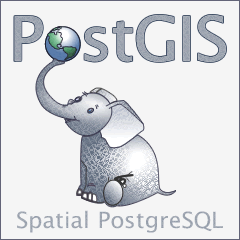PostGIS 3.6.0dev Manual
DEV (Wed 23 Oct 2024 07:18:55 AM UTC rev. 1dca456 )
Abstract
PostGIS is an extension to the PostgreSQL object-relational database system which allows GIS (Geographic Information Systems) objects to be stored in the database. PostGIS includes support for GiST-based R-Tree spatial indexes, and functions for analysis and processing of GIS objects.


This is the manual for version 3.6.0dev
 This work is licensed under a Creative Commons Attribution-Share Alike 3.0 License.
Feel free to use this material any way you like, but we ask that you attribute credit to the PostGIS Project
and wherever possible, a link back to https://postgis.net.
This work is licensed under a Creative Commons Attribution-Share Alike 3.0 License.
Feel free to use this material any way you like, but we ask that you attribute credit to the PostGIS Project
and wherever possible, a link back to https://postgis.net.
Table of Contents
- 1. Introduction
- 2. PostGIS Installation
- 3. PostGIS Administration
- 4. Data Management
- 5. Spatial Queries
- 6. Performance Tips
-
7. PostGIS Reference
- 7.1. PostGIS Geometry/Geography/Box Data Types
- 7.2. Table Management Functions
- 7.3. Geometry Constructors
- 7.4. Geometry Accessors
- 7.5. Geometry Editors
- 7.6. Geometry Validation
- 7.7. Spatial Reference System Functions
- 7.8. Geometry Input
- 7.9. Geometry Output
- 7.10. Operators
- 7.11. Spatial Relationships
- 7.12. Measurement Functions
- 7.13. Overlay Functions
- 7.14. Geometry Processing
- 7.15. Coverages
- 7.16. Affine Transformations
- 7.17. Clustering Functions
- 7.18. Bounding Box Functions
- 7.19. Linear Referencing
- 7.20. Trajectory Functions
- 7.21. Version Functions
- 7.22. Grand Unified Custom Variables (GUCs)
- 7.23. Troubleshooting Functions
- 8. SFCGAL Functions Reference
-
9. Topology
- 9.1. Topology Types
- 9.2. Topology Domains
- 9.3. Topology and TopoGeometry Management
- 9.4. Topology Statistics Management
- 9.5. Topology Constructors
- 9.6. Topology Editors
- 9.7. Topology Accessors
- 9.8. Topology Processing
- 9.9. TopoGeometry Constructors
- 9.10. TopoGeometry Editors
- 9.11. TopoGeometry Accessors
- 9.12. TopoGeometry Outputs
- 9.13. Topology Spatial Relationships
- 9.14. Importing and exporting Topologies
- 10. Raster Data Management, Queries, and Applications
-
11. Raster Reference
- 11.1. Raster Support Data types
- 11.2. Raster Management
- 11.3. Raster Constructors
- 11.4. Raster Accessors
- 11.5. Raster Band Accessors
- 11.6. Raster Pixel Accessors and Setters
- 11.7. Raster Editors
- 11.8. Raster Band Editors
- 11.9. Raster Band Statistics and Analytics
- 11.10. Raster Inputs
- 11.11. Raster Outputs
- 11.12. Raster Processing: Map Algebra
- 11.13. Built-in Map Algebra Callback Functions
- 11.14. Raster Processing: DEM (Elevation)
- 11.15. Raster Processing: Raster to Geometry
- 11.16. Raster Operators
- 11.17. Raster and Raster Band Spatial Relationships
- 11.18. Raster Tips
- 12. PostGIS Extras
-
13. PostGIS Special Functions Index
- 13.1. PostGIS Aggregate Functions
- 13.2. PostGIS Window Functions
- 13.3. PostGIS SQL-MM Compliant Functions
- 13.4. PostGIS Geography Support Functions
- 13.5. PostGIS Raster Support Functions
- 13.6. PostGIS Geometry / Geography / Raster Dump Functions
- 13.7. PostGIS Box Functions
- 13.8. PostGIS Functions that support 3D
- 13.9. PostGIS Curved Geometry Support Functions
- 13.10. PostGIS Polyhedral Surface Support Functions
- 13.11. PostGIS Function Support Matrix
- 13.12. New, Enhanced or changed PostGIS Functions
- 14. Reporting Problems
- A. Appendix